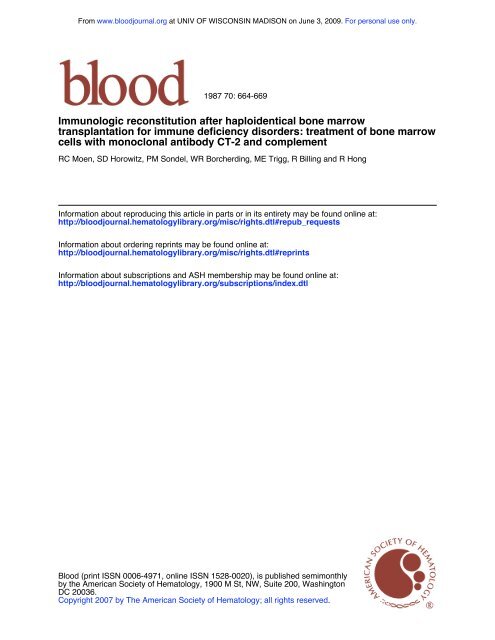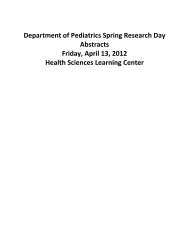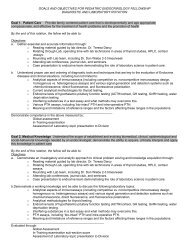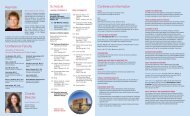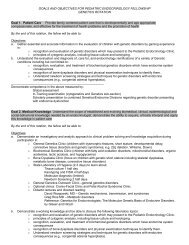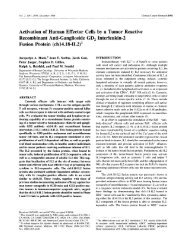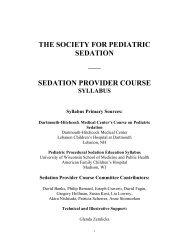Moen RC, Horowitz SD, Sondel PM, Borcherding WR, Trigg ME ...
Moen RC, Horowitz SD, Sondel PM, Borcherding WR, Trigg ME ...
Moen RC, Horowitz SD, Sondel PM, Borcherding WR, Trigg ME ...
You also want an ePaper? Increase the reach of your titles
YUMPU automatically turns print PDFs into web optimized ePapers that Google loves.
From www.bloodjournal.org at UNIV OF WISCONSIN MADISON on June 3, 2009. For personal use only.<br />
1987 70: 664-669<br />
Immunologic reconstitution after haploidentical bone marrow<br />
transplantation for immune deficiency disorders: treatment of bone marrow<br />
cells with monoclonal antibody CT-2 and complement<br />
<strong>RC</strong> <strong>Moen</strong>, <strong>SD</strong> <strong>Horowitz</strong>, <strong>PM</strong> <strong>Sondel</strong>, <strong>WR</strong> <strong>Borcherding</strong>, <strong>ME</strong> <strong>Trigg</strong>, R Billing and R Hong<br />
Information about reproducing this article in parts or in its entirety may be found online at:<br />
http://bloodjournal.hematologylibrary.org/misc/rights.dtl#repub_requests<br />
Information about ordering reprints may be found online at:<br />
http://bloodjournal.hematologylibrary.org/misc/rights.dtl#reprints<br />
Information about subscriptions and ASH membership may be found online at:<br />
http://bloodjournal.hematologylibrary.org/subscriptions/index.dtl<br />
Blood (print ISSN 0006-4971, online ISSN 1528-0020), is published semimonthly<br />
by the American Society of Hematology, 1900 M St, NW, Suite 200, Washington<br />
DC 20036.<br />
Copyright 2007 by The American Society of Hematology; all rights reserved.
From www.bloodjournal.org at UNIV OF WISCONSIN MADISON on June 3, 2009. For personal use only.<br />
Immunologic Reconstitution After Haploidentical Bone Marrow Transplantation<br />
for Immune Deficiency Disorders: Treatment of Bone Marrow Cells<br />
With Monoclonal Antibody CT-2 and Complement<br />
By R.C. Moon, S.D. <strong>Horowitz</strong>, P.M. <strong>Sondel</strong>, W.R. <strong>Borcherding</strong>, M.E. <strong>Trigg</strong>, R. Billing, and R. Hong<br />
Patients with congenital T lymphocyte deficiency disorders<br />
received transplants with parental bone marrow depleted<br />
of mature T cells by the use of an anti-T cell monoclonal<br />
antibody (CT-2) and complement. Our results with 16<br />
consecutive patients (20 transplants) showed rapid<br />
engraftment of donor cells; cytoreduction (busulfan. cytosine<br />
arabinoside [ara-CJ. cyclophosphamide) was used in<br />
six transplants. and marrow ablation was used in six<br />
(ara-C. cyclophosphamide. 1 .365-cGy total body irradiation).<br />
No patient received prophylactic anti-graft-v-host<br />
disease (GVHD) therapy posttransplant, and only one<br />
patient developed significant GVHD. which involved the<br />
skin. liver. and gastrointestinal tract. Seven others showed<br />
some manifestations of GVHD. but these were of minimal<br />
clinical significance and required only occasional steroid<br />
therapy. Overall. eight patients are alive and well; eight did<br />
not survive. Polyclonal immunoglobulin synthesis by donor<br />
memory B cells was seen shortly after transplantation.<br />
with peak donor-derived serum levels seen approximately<br />
2 months after transplantation. After this initial immuneglobulin<br />
synthesis waned. another wave of B cell responses<br />
developed. This immunoglobulin response appears to be<br />
permanent. T cell functions appeared as soon as 3 weeks<br />
after transplantation. This experience in a variety of<br />
patients with combined immunodeficiency who received<br />
transplants with monoclonal antibody T cell-depleted marrow<br />
shows gratifying results with a consistent T and B cell<br />
benefit.<br />
a 1987 by Grune & Stratton, Inc.<br />
S EVERE COMBINED IMMUNE DEFICIENCY<br />
(SCID) can be successfully treated with transplantation<br />
of bone marrow from HLA-identical siblings. Unfortunately,<br />
the majority of affected individuals will lack an<br />
HLA-identical bone marrow transplant (BMT) donor. To<br />
offer BMT therapy to patients without suitably matched<br />
stem cell donors, immunocompetent T cells have been<br />
removed from bone marrow by antibodies to T cells’ or by<br />
agglutination with soybean lectin or sheep erythrocytes.58<br />
We report our results in I 6 consecutive patients with immunodeficiency<br />
syndromes receiving parental marrow depleted<br />
of T lymphocytes by the use of the monoclonal antibody<br />
CT-2 and complement. This procedure has resulted in marrow<br />
engraftment and reconstitution of both B and T cell<br />
functions with minimal graft-v-host disease (GVHD).<br />
MATERIALS AND <strong>ME</strong>THODS<br />
Donor and recipient characteristics. The diagnoses of the<br />
patients included SCID (adenosine deaminase [ADA]-positive and<br />
-negative), Wiskott-Aldrich syndrome (WAS), and cartilage-hair<br />
hypoplasia (CHH) (Tables 1 and 2). Of the I I ADA-positive SCID<br />
From the Department of Pediatrics, University of Wisconsin,<br />
Madison.<br />
Submitted September 12, 1986; accepted April 30, 1987.<br />
Supported in part by Grant No. A! 10404 from National Institutes<br />
of Health.<br />
Presented in part at the Keystone UCLA conference. April 1986.<br />
<strong>ME</strong>. T. is now affiliated with the Department of Pediatrics,<br />
University of Iowa, Iowa City. RB. is now affiliated with the<br />
Conejo Valley Cancer Center. Westlake Village. CA.<br />
Address reprint requests to R. Hong. MD. Department of Pediatrics.<br />
University of Wisconsin Clinical Science Center, 600 Highland<br />
Ave K4/434, Madison, WI 53792.<br />
The publication costs ofthis article were defrayed in part by page<br />
charge payment. This article must therefore be hereby marked<br />
“advertisement” in accordance with 18 U.S.C. §1734 solely to<br />
indicate this fact.<br />
© I 987 by Grune & Stratton, Inc.<br />
0006-4971/87/7003-0009$3.OO/O<br />
patients, eight had disproportionate amounts of B cells, the most<br />
common variety. Three patients had normal to elevated Ig responses<br />
but had had prior thymus transplants. Three (patient nos. 34, 86,<br />
and 87) had, before therapy, levels of immunoglobulins consistent<br />
with the diagnosis ofSCID with immunoglobulins. Informed written<br />
consent for bone marrow transplantation with donor bone marrow<br />
depleted of T lymphocytes was obtained. All protocols for transplantation<br />
were approved by the Human Subjects Committee of the<br />
University of Wisconsin.<br />
BMT preparation regimens. Busulfan (4 mg/kg/d orally for<br />
four days) was used for patients under 2 years of age to avoid the<br />
CNS toxicity of total body irradiation (TBI) (Table 1 ). Otherwise,<br />
fractionated TBI was administered at a dose of 1,320 cOy (165<br />
cGy x 8) with only the eyes shielded (patient no. 80) or both eyes<br />
and lungs shielded (patient nos. 87 and 100). Cyclophosphamide was<br />
used in all patients receiving myeloablative therapy. Cytosine arabinoside<br />
(six doses of 3 g/m2 or 2 g/m2 [transplant 105]) was added to<br />
the preparative regimen to further immunosuppress the recipient<br />
because the experience with patient no. 26 and with patients<br />
receiving T cell-depleted BMT for hematologic malignancy has<br />
demonstrated that further immunosuppression is necessary to prevent<br />
graft rejection by the host.9<br />
Bone marrow harvest, T cell depletion, and transpiantalion.<br />
Bone marrow was aspirated from posterior iliac crests,<br />
depleted of T cells, and infused as described previously.4 Only one<br />
cycle of antibody and complement were used for each marrow<br />
treatment. E rosette-positive and TI 1-positive cells are completely<br />
removed by this treatment (Tl I + cells were measured by flow<br />
cytometry). Mixed leukocyte reactivity and cytotoxic T cell generation<br />
against allogeneic targets was usually but not invariably<br />
decreased. Patient nos. 28 to 1 15 also received a portion (5% to 30%)<br />
of donor marrow cells directly into their marrow space. Four to IS<br />
mL ofconcentrated marrow cells was injected into the posterior iliac<br />
crest(s).”<br />
Assessment of engraftment and G VHD. The latest assessment<br />
ofT lymphocytes is shown in Table 3. Engraftment ofdonor marrow<br />
was also documented by HLA phenotyping of peripheral blood<br />
lymphocytes and where possible by karyotypic analysis of peripheral<br />
blood lymphocytes and RBC phenotyping.<br />
The severity of GVHD was defined by the Seattle criteria.”<br />
Diarrhea fluid loss for staging of GVHD of the gastrointestinal tract<br />
was adjusted according to patient surface area, assuming an average<br />
adult value of 1 732<br />
664 Blood, Vol 70, No 3 (September), 1987: pp 664-669
From www.bloodjournal.org at UNIV OF WISCONSIN MADISON on June 3, 2009. For personal use only.<br />
T CELL DEPLETED BONE MARROW TRANSPLANT 665<br />
Table I . Cli nical Data<br />
State of BM GVHD# Months<br />
uPN Disease Age Pre * Prey T4 Health) Dosell (S/L/G) F/U Outcomett<br />
Alive<br />
028 SCID 20 None CTF Good 1 1.3 2/1/0 39 Well<br />
057 SCID 6 None None Fair 12.2 1/0/0 27 Well<br />
080 SCID 55 ARA-6. C2, TBI CTF Good 4.7 1/0/0 19 Well<br />
087 SCID 65 ARA-6, C2, TBI TP5 Good 4.6 1/0/0 1 6 Well<br />
094 SCID 10 None None Good 1 9.4 3/0/0 1 5 Well<br />
026 WAS 2 B4, C4 None Good 9.8 0/0/0 39 Well<br />
lOOa ADA 83 None CiT Poor 4.8 0/0/0 2.5 Temporary engr<br />
bOb 85 ARA-6, C2. TBI None Poor 3.7 1/2/0 10 Improved<br />
105 ADA 4 ARA-6, c2, B4 None Fair 5.7 1/0/0 14 Well<br />
Not alive<br />
023a SCID 1 2 None None Good 8. 1 0/0/0 5 No engraftment<br />
023b 1 7 B4, C4 See 23a Poor 8.4 NE - Died (4)<br />
027 SCID 56 None CTF Poor 9.5 2/1/0 - Died (28)<br />
034 SCID 52 B4.C4 None Good 5.0 NE - Died (0)<br />
086a SCID 23 None None Fair 6.5 0/0/0 9 Temporary engr<br />
086b 34 ARA-6,C2,T8I See86a Poor NE - Died(-2)<br />
093 SCID 58 ARA-6,C2.TBI CTF Poor 6.6 NE - Died(14)<br />
099a SCID 80 None CTF Good 9.6 0/0/0 5 No engraftment<br />
099b 86 ARA-6, C2, TBI See 99a Good 8.0 2/1/0 - Died (22)<br />
1 10 CHH 1 3 ARA-6, C2, B4 None Fair 6. 1 3/2/2 - Died (15)<br />
1 1 5 ADA 27 ARA-6. C2. B4 None Good 1 2.8 1/0/0 - Died (9)<br />
UPN, unique patient number. Patient nos. 23, 86, 99, and 100 received transplants on two occasions (a - 1st transplant; b 2nd transplant). Only<br />
patient nos. 87 and 100 are female.<br />
tA e at the time of transplant in months.<br />
B4, busulfan, 4 mg/kg/d x 4; C4, Cytoxan, 50 mg/kg/d x 4; c2, Cytoxan, 50 mg/kg/d x 2 except for patient nos. 105. 1 10, and 1 1 5 (45<br />
mg/kg/d x 2); ARA-6, ara C, 3 g/m2 every 12 hours x 6 except patient nos. 105, 1 10. and 1 15 where the dose was 2 g/m2; TBI, 1.320 rad in eight<br />
divided dOSeS. Patient no. 7 had his eyes shielded. Patient nos. 87 and 100 had lungs and eyes shielded.<br />
§Previous therapy: CiT. cultured thymus fragment; TP5, thymopoietin pentapeptide.<br />
State of health at the time of transplant: good, essentially normal; fair, slightly undernourished, past history of serious infection; po , actively<br />
infected, marked wasting, often chronic diarrhea.<br />
#{182}Dose of nucleated cells x 108/kg body weight administered after T cell depletion.<br />
#S/L/G indicates the degree of involvement of skin, liver, and gut, respectively. The number indicates the clinical stage of involvement using Seattle<br />
criteria (see the text). NE, not evaluated.<br />
#{149} C Months of follow-up since transplant.<br />
ttSee the text for details of death. Immune status is shown in subsequent tables. Temporary engr. temporary engraftment. The numbers in<br />
parentheses are the days of death relative to BMT.<br />
Monoclonal antibody cell surface markers. Antibodies directed<br />
against various mononuclear cell populations were used for flow<br />
cytometric analysis. The antibodies used were OKT3, OKT4,<br />
OKT6, OKT8, Leu 1 1, Leu 7, anti-HLA-DR, BI, and B4.<br />
Tcellfunctions. Mononuclear cells obtained by Ficoll-Hypaque<br />
separation were assessed for proliferative responses to mitogens,<br />
antigens and alloantigens and cytotoxic responses to alloantigen<br />
targets by the usual methods.’2<br />
B cell function testing. Serum immunoglobulin levels were<br />
determined by rate nephelometry using a Beckman ICS Analyzer II<br />
(Beckman Instruments, Inc. Fullerton, CA). Specific antibody levels<br />
of IgG, IgA, and 1gM to the antigens Escherichia coli, tetanus<br />
toxoid, and diphtheria-tetanus toxoids were determined by an<br />
enzyme-linked immunosorbent assay (ELISA).’3 IgE levels were<br />
determined by using an ELISA assay (Epsilon IgE, Beckman<br />
Instruments, Inc, Carlsbad, CA).<br />
RESULTS<br />
As shown in Table 1,1 6 patients overall received transplants.<br />
Eight are alive and well; eight have died. The major<br />
cause of death was infection. Of the 16 transplant recipients<br />
there were 1 1 patients with ADA-positive SCID, three<br />
patients with ADA deficiency, one with CHH, and one<br />
patient with WAS. The age at the time of transplant varied<br />
from 2 months to 72/,2 years. The father was the BMT donor<br />
for all transplants except for patient 99 where the mother<br />
served as the donor. All donors and recipients were haploidentical,<br />
except as noted. Donor cells were reactive against<br />
the host in mixed lymphocyte culture (MLC) except for<br />
patient no. 26 who was MLC compatible, HLA-B, -C, and<br />
-DR identical, but HLA-A disparate with his donor (Table<br />
2). Cytoreduction or ablative pretreatment was used in I 2 of<br />
the 20 transplants performed. At the time of transplant or<br />
transplant conditioning, the recipient was in good health in<br />
ten, fair health in four (transplant nos. 57, 86, 105, and 1 10),<br />
and in poor health in six (transplant nos. 23, 27, 86, 93, and<br />
100) instances.<br />
The number of treated nucleated bone marrow cells<br />
received varied from 3.7 x 108/kg to 19.4 x l08/kg. In those<br />
patients receiving immunosuppressive treatment before<br />
transplantation, engnaftment of WBC was present 12 to 20<br />
days after transplantation. Patients nos. 23 and 99 did not<br />
show engraftment and died during a second transplant
From www.bloodjournal.org at UNIV OF WISCONSIN MADISON on June 3, 2009. For personal use only.<br />
666 MOEN ET AL<br />
Tab Ic 2. Im munolog ic Cha racteristi cs at Ti me of Transplant<br />
D yR<br />
PN Lymphs Ti 1 T3 T4 T8 MLCt B 1 lgG gA 1gM HLA Dispar MLC<br />
Alive<br />
SCID<br />
028 273 1 1 0 0 0 15 32411
From www.bloodjournal.org at UNIV OF WISCONSIN MADISON on June 3, 2009. For personal use only.<br />
T CELL DEPLETED BONE MARROW TRANSPLANT 667<br />
attempt. In transplant nos. 86 and 100 only transient<br />
engraftment occurred; patient no. 86 died before a retransplant<br />
could be performed, but patient no. 100 has subsequently<br />
received a successful transplant. Thus, in toto, of the<br />
16 patients, 8 are alive and well and show engraftment.<br />
Patient no. 26 initially showed donor engraftment of all cell<br />
lines. He has continued to demonstrate good donor T cell<br />
engraftment, but his red cells, platelets, monocytes, and B<br />
lymphocytes are now entirely of the host type. He is chimeric<br />
for Tcells.<br />
GVHD. Engraftment occurred without significant<br />
GVHD (Table 1). Only one patient (no. 1 10) demonstrated<br />
GVHD of greater than grade 2 severity. In patient no. 94<br />
stage III skin GVHD was present without liver or gastrointestinal<br />
involvement. This patient and patient no. 1 10 were<br />
treated with high-dose steroid therapy to control the acute<br />
GVHD.’4 Patient nos. 28, 57, 87, and 100 required low-dose<br />
prednisone therapy ( 1 to 2 mg/kg) for brief periods of time<br />
(1 to 3 weeks). Patient nos. 80 and 105 did not receive any<br />
steroid therapy for transient acute GVHD of the skin with<br />
minimal liver involvement. Only patient no. 1 10 had clinical<br />
evidence ofgastrointestinal GVHD. Chronic GVHD has not<br />
occurred.<br />
T cell reconstitution. From 3 to 1 2 weeks were required<br />
before greater than 100 cells/zL stained with each of the<br />
monoclonal antibodies listed. At no time after transplantation<br />
were cells staining with monoclonal antibody OKT6<br />
(indicative of thymocytes) found in peripheral blood. In all<br />
cases, the number of T8 + cells exceeded the number of T4 +<br />
cells for many months after transplantation. Table 3 lists the<br />
relative number of T cells seen at the time of the most recent<br />
follow-up.<br />
Six to I 8 weeks were required after transplantation before<br />
significant proliferation was observed in response to the<br />
mitogens phytohemagglutinin (PHA), concanavalin A (Con<br />
A), and pokeweed mitogen (PWM) and 48 weeks for the<br />
soluble antigen Candida. Significant proliferation was<br />
defined as the attainment of a level of proliferation in excess<br />
of 3 <strong>SD</strong> of the mean response observed before treatment in 34<br />
newly diagnosed patients with severe combined immunodeficiency<br />
syndrome (ADA + ). Allogeneic cell (MLC) reactivity<br />
was found by the 12th week. In almost all cases (except<br />
patient no. 100) the proliferative responses were preceded by<br />
the acquisition of significant numbers of T cells as determined<br />
by monoclonal markers.<br />
B cell reconstitution. The acquisition of B cell function<br />
revealed a novel pattern. Since all patients were receiving<br />
intravenous gamma globulin preparations, we evaluated<br />
endogenous B cell function by following the IgA and 1gM<br />
responses. Most patients showed substantial elevations in<br />
IgA and/or 1gM levels, which peaked about 2 months after<br />
transplantation. The serum levels subsequently decreased<br />
only to rise again many months later. These immunoglobulin<br />
changes occurred in all patients, even those not requiring any<br />
blood product support posttransplant. Table 4 provides a<br />
summary of current immunoglobulin levels and functional<br />
antibody analyses for all surviving patients.<br />
The IgE level remained
From www.bloodjournal.org at UNIV OF WISCONSIN MADISON on June 3, 2009. For personal use only.<br />
668 MOEN ET AL<br />
Table 4. B Cell Assessment<br />
Responses to Specific Antigens<br />
E coli<br />
Diphtheria<br />
Tetanus<br />
Total<br />
Ig<br />
UPN Ig Before<br />
Nowt<br />
Before<br />
Now<br />
Before<br />
Now<br />
Isotypes<br />
IgE<br />
028 IgG 0 150 0 120 0 42 622
From www.bloodjournal.org at UNIV OF WISCONSIN MADISON on June 3, 2009. For personal use only.<br />
T CELL DEPLETED BONE MARROW TRANSPLANT 669<br />
consistently observed in patients with primary immunodeficiency.<br />
Cytoreduction or ablation is often necessary but<br />
needs to be properly defined and the agents carefully chosen<br />
so as not to significantly add to the morbidity of the<br />
transplant<br />
procedure.<br />
NOTE ADDED IN PROOF<br />
Patient no. 100 now has normal immunity. Patient no. 26 was<br />
retransplanted without further immunosuppression or T cell depletion<br />
of the marrow and has a normal platelet count.<br />
ACKNOWLEDG<strong>ME</strong>NT<br />
Dedicated expert clinical care was provided by the house staff and<br />
nursing service of the University of Wisconsin Clinical Science<br />
Center. Coordination of complex interdisciplinary procedures was<br />
efficiently accomplished by Bridget Flynn. The referral of patients<br />
by Drs G. Brashear, i. Casper, R. Cole, L. Eggman, R. Friedman, P.<br />
Krueger, K. Rich, T. Silberstein, i. Twiggs, R. Wappner, and i.<br />
Winkelstein is gratefully acknowledged. CT-2 monoclonal antibody<br />
was generously provided by the Conejo Valley Cancer Center,<br />
Westlake Village, CA.<br />
REFERENCES<br />
1. Reinherz EL, Geha R, Rappeport iM, Wilson M, Penta AC,<br />
Hussey RE, Fitzgerald KA, Daley iG, Levine H, Rosen FS,<br />
Schlossman SE: Reconstitution after transplantation with T lymphocyte<br />
depleted HLA haplotype mismatched bone marrow for<br />
severe combined immunodeficiency. Proc NatI Acad Sci USA<br />
79:6047, 1982<br />
2. Prentice HG, ianossy G, Price-Jones L. Trejdosiewicz LK,<br />
Panjwani D, Graphakos 5, Ivory K, Blacklock KA, Gilmore MJML,<br />
Tidman N, Skeggs DBL, Ball 5, Patterson J, ioffbrand AV:<br />
Depletion of T lymphocytes in donor marrow prevents significant<br />
graft-versus-host disease in matched allogeneic leukemic marrow<br />
transplant recipients. Lancet 1 :472, 1984<br />
3. Filipovich AH, Vallera DA, Youle Ri, Quinones RR, Neville<br />
JDM, Kersey iH: Ex-vivo treatment of donor bone marrow with<br />
anti-T-cell immunotoxins for prevention of graft-versus-host disease.<br />
Lancet 1:469, 1984.<br />
4. <strong>Trigg</strong> <strong>ME</strong>, Peterson A, Erickson C, Bozdech M, Billing R,<br />
<strong>Sondel</strong> <strong>PM</strong>, Finlay i, Surfus J, Stuiber M, Hong R: Depletion ofT<br />
cells from bone marrow for allogeneic transplantation: Method for<br />
treatment of bone marrow in bulk. Exp Hematol 14:21 , 1986<br />
5. Reisner Y, Kapoor N, Kirkpatrick D, Pollack MS. Cunningham-Rundles<br />
5, Dupont B, Hodes MZ, Good RA, O’Reilly R:<br />
Transplantation for severe combined immunodeficiency with HLA-<br />
A,B,D,DR incompatible parental marrow cells fractionated by<br />
soybean agglutinin and sheep red cells. Blood 61 :341 , 1983<br />
6. Cowan Mi, Wara DW, Weintrut PS, Pabst H, Ammann Ai:<br />
Haploidentical bone marrow transplantation for severe combined<br />
immunodeficiency disease using soybean agglutinin-negative T-<br />
depleted marrow cells. i Clin Immunol 5:370, 1985<br />
7. Fischer A, Durandy A, Dc Villartay JP, Vilmer E, Griscelli C:<br />
HLA-haploidentical bone marrow transplantation for severe combined<br />
immunodeficiency using E-rosette fractionation and cyclosporine<br />
A. Transplant Proc 17:447, 1985<br />
8. Buckley RH, SchiffSE, Sampson HA, Schiff RI, Ammerman<br />
BE, iohnson RR, Ward FE: Development of immunity in severe<br />
primary T cell deficiency following haploidentical bone marrow<br />
stem cell transplantation. J Immunol 137:2398, 1986<br />
9. <strong>Sondel</strong> <strong>PM</strong>, Bozdech Mi, <strong>Trigg</strong> <strong>ME</strong>, Hong R, Finlay iL,<br />
Kohler PC, Longo W, Hank iA, Billing R, Steeves R, Flynn B:<br />
Additional immunosuppression allows engraftment following HLAmismatched<br />
T cell-depleted bone marrow transplantation for leukemia.<br />
Transplant Proc 17:460, 1985<br />
10. Hong R, <strong>Horowitz</strong> 5, <strong>Moen</strong> R, <strong>Trigg</strong> M, <strong>Sondel</strong> P, Billing R,<br />
<strong>Borcherding</strong> W, Johnson iP, Kanoff M, Bias WB, Winkelstein J:<br />
Thymus and B cell reconstitution in severe combined immunodeficiency<br />
after transplantation of monoclonal antibody depleted parental<br />
mismatched bone marrow. Bone Marrow Transplant 1:40S,<br />
1987.<br />
1 1. Glucksberg H, Storb R, Fefer A, Buckner CD, Neiman PE,<br />
Clift RA, Lerner KG, Thomas ED: Clinical manifestations of<br />
graft-versus-host disease in human recipients of marrow from HLA<br />
matched sibling donor. Transplantation 18:295, 1974<br />
12. Maluish AE, Strong DM: Lymphocyte proliferation, in Rose<br />
N, Friedman H, Fahey iL (eds): Manual of Clinical Laboratory<br />
Immunology. Washington, DC, American Society for Microbiology,<br />
1986, p 274<br />
13. <strong>Moen</strong> <strong>RC</strong>, Oemichen SL, Kiggens Ai, Hong R: ELISA<br />
detection of specific functional antibodies in human serum to E co/i,<br />
tetanus toxoid, and diphtheria-tetanus toxoids: Normal values for<br />
IgG, lgA and 1gM. Diagn Immunol 4:17, 1986<br />
14. Kanojia MD, Anagnostou AA, Zander AR, Vellekoop L,<br />
Spitzer G, Verma D5, iagannath 5, Dicke KA: High-dose methylprednisolone<br />
treatment for acute graft-versus-host disease after bone<br />
marrow transplantation in adults. Transplantation 37:246, 1984<br />
15. O’Reilly Ri: Transplantation of soybean lectin treated bone<br />
marrow in primary immunodeficiency, in Champlin R, Gale RP<br />
(eds): Recent Advances in Bone Marrow Transplantation. New<br />
York, Liss, 1986, p 483<br />
16. Parkman R, Rappeport D, Geha R, Cassady R, Levey R,<br />
Nathan DG, Belli i, Rosen F: Complete correction of the Wiskott-<br />
Aldrich syndrome by allogeneic bone marrow transplantation. N<br />
Engl i Med 298:921, 1978<br />
17. Pollack MS, Kirkpatrick D, Kapoor N, Dupont B, O’Reilly<br />
Ri: Identification by HLA typing of intrauterine derived maternal T<br />
cells in four patients with severe combined immunodeficiency. N<br />
EngI i Med 307:662, 1982<br />
18. Blazar BR, Ramsay NKC, Kersey iH, Krivit W, Arthur DC,<br />
Filipovich AH: Pre-transplant conditioning with busulfan (myeleran)<br />
and cyclophosphamide for nonmalignant diseases. Assessment of<br />
engraftment following histocompatible allogeneic bone marrow<br />
transplantation. Transplantation 39:597, 198S<br />
19. <strong>Trigg</strong> <strong>ME</strong>, Finlay iL, Bozdech M, Gilbert E: Fatal cardiac<br />
toxicity in bone marrow transplant patients receiving cytosine arabinoside,<br />
cyclophosphamide, and total body irradiation. Cancer 59:38,<br />
1987<br />
20. Moore SB, Motschman TL, Dewald GW, Letendre L, Smithson<br />
WA, Hoagland HC: A case of unusually early but temporary<br />
humoral immune reconstitution after bone marrow transplantation.<br />
Transplantation 39:675, 1985<br />
21. Hows i, Beddow K, Gordon-Smith E, Branch DR. Spruce W,<br />
Sniecinski I, Krance RA, Petz LD: Donor-derived red blood cell<br />
antibodies and immune hemolysis after allogeneic bone marrow<br />
transplantation. Blood 67:177, 1986<br />
22. Friedrich W, Goldmann SF, Vetter U, Fliedner TM, Heymer<br />
B, Peter HH, Reisner Y, Kleihauer E: Immunoreconstitution in<br />
severe combined immunodeficiency after transplantation of HLAhaploidentical,<br />
T-cell depleted bone marrow. Lancet 1:761, 1984<br />
23. <strong>Trigg</strong> <strong>ME</strong>, Finlay JL, <strong>Sondel</strong> <strong>PM</strong>: Use of acyclovir in bone<br />
marrow transplant patients. N EngI J Med 312:1708, 1985


